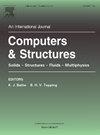3d打印混凝土结构的周动力各向异性性能分析
IF 4.8
2区 工程技术
Q1 COMPUTER SCIENCE, INTERDISCIPLINARY APPLICATIONS
引用次数: 0
摘要
3d打印混凝土(3d - printing concrete, 3DPC)作为一种分层施工方法,在层与层之间引入了弱界面,导致不同方向的力学行为不同。大多数研究都是基于实验样品尺度的样品来研究这种各向异性行为,而没有将其应用于实际工程中。为了满足这一需求,本文开发了一种用于三维pc结构各向异性行为分析的周动力学(PD)方法。3DPC的界面是基于键的方法,可以通过键划分进行识别,并通过PD中键性质的还原进行建模,为结构分析建立了简单的数值格式。通过基于键的对应关系,引入双标量塑性损伤模型来描述3d打印后的硬化性能。在此基础上,考虑了极端荷载的威胁,考虑了极端荷载下结构的各向异性。通过两个试验对所建立的方法进行了严格的验证,并最终应用于某拱桥的系统数值研究,包括静力和动力两种情况。研究结果对三维pc结构的各向异性行为有了深入的了解。此外,该方法在指导3D打印设计和确定最优打印方向方面表现出良好的性能,证明了其在实际工程应用中的能力。本文章由计算机程序翻译,如有差异,请以英文原文为准。
Peridynamic anisotropic behavior analysis of 3D-printed concrete structures
As a layer-wise construction method, 3D-printed concrete (3DPC) introduces weak interfaces between layers, resulting in different mechanical behavior in different directions. Most studies investigate this anisotropic behavior based on experimental specimen-scale samples and do not apply it in practical engineering. To address this need, the present paper develops a peridynamic (PD) method for the anisotropic behavior analysis of 3DPC structures. As a bond-based method, the interfaces of 3DPC are easily identified by bond division and modeled by reducing bond properties in PD, establishing a simple numerical scheme for structural analysis. Through bond-based correspondence, the bi-scalar plasticity-damage model is incorporated to describe the hardened properties of 3DPC after printing. On this basis, the dynamic effect is included to consider the threat of extreme loads, under which structures show more pronounced anisotropic behavior. The developed method is rigorously verified against two experiments and is finally applied to a systematic numerical study of an arch bridge, including both static and dynamic cases. The results provide a deep understanding of the anisotropic behavior of 3DPC structures. Furthermore, the proposed method shows good performance in guiding 3D printing design and determining the optimal printing direction, demonstrating its capability for practical engineering applications.
求助全文
通过发布文献求助,成功后即可免费获取论文全文。
去求助
来源期刊

Computers & Structures
工程技术-工程:土木
CiteScore
8.80
自引率
6.40%
发文量
122
审稿时长
33 days
期刊介绍:
Computers & Structures publishes advances in the development and use of computational methods for the solution of problems in engineering and the sciences. The range of appropriate contributions is wide, and includes papers on establishing appropriate mathematical models and their numerical solution in all areas of mechanics. The journal also includes articles that present a substantial review of a field in the topics of the journal.
 求助内容:
求助内容: 应助结果提醒方式:
应助结果提醒方式:


